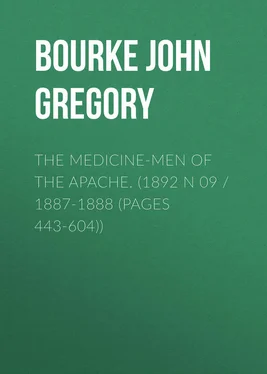John Bourke - The Medicine-Men of the Apache. (1892 N 09 / 1887-1888 (pages 443-604))
Здесь есть возможность читать онлайн «John Bourke - The Medicine-Men of the Apache. (1892 N 09 / 1887-1888 (pages 443-604))» — ознакомительный отрывок электронной книги совершенно бесплатно, а после прочтения отрывка купить полную версию. В некоторых случаях можно слушать аудио, скачать через торрент в формате fb2 и присутствует краткое содержание. Жанр: foreign_antique, foreign_prose, на английском языке. Описание произведения, (предисловие) а так же отзывы посетителей доступны на портале библиотеки ЛибКат.
- Название:The Medicine-Men of the Apache. (1892 N 09 / 1887-1888 (pages 443-604))
- Автор:
- Жанр:
- Год:неизвестен
- ISBN:нет данных
- Рейтинг книги:4 / 5. Голосов: 1
-
Избранное:Добавить в избранное
- Отзывы:
-
Ваша оценка:
- 80
- 1
- 2
- 3
- 4
- 5
The Medicine-Men of the Apache. (1892 N 09 / 1887-1888 (pages 443-604)): краткое содержание, описание и аннотация
Предлагаем к чтению аннотацию, описание, краткое содержание или предисловие (зависит от того, что написал сам автор книги «The Medicine-Men of the Apache. (1892 N 09 / 1887-1888 (pages 443-604))»). Если вы не нашли необходимую информацию о книге — напишите в комментариях, мы постараемся отыскать её.
The Medicine-Men of the Apache. (1892 N 09 / 1887-1888 (pages 443-604)) — читать онлайн ознакомительный отрывок
Ниже представлен текст книги, разбитый по страницам. Система сохранения места последней прочитанной страницы, позволяет с удобством читать онлайн бесплатно книгу «The Medicine-Men of the Apache. (1892 N 09 / 1887-1888 (pages 443-604))», без необходимости каждый раз заново искать на чём Вы остановились. Поставьте закладку, и сможете в любой момент перейти на страницу, на которой закончили чтение.
Интервал:
Закладка:
The Cenis (Asinai) of Texas, were seen by La Salle's expedition in 1687-1690, torturing a captive squaw. "They then tore out her hair, and cut off her fingers." 143 143 Charlevoix, New France, New York, 1866, vol. 4, p. 105.
In volume 2 of Kingsborough's Mexican Antiquities, in the plates of the Vatican manuscript, is to be seen a representation of an Aztec priest or other dignitary holding out in his hands two human arms. In plate 76 of the same is a priest offering up a human sacrifice, the virile member of the victim cut off.
Teoyamaqui, the wife of Huitzlipochtli, the Aztec god of war, was depicted with a necklace of human hands. 144 144 Squier, Serpent Symbol, p. 197.
Squier also says that Darga or Kali, the Hindu goddess, who corresponds very closely to her, was represented with "a necklace of skulls" and "a girdle of dissevered human hands."
The Hindu goddess Kali was decorated with a necklace of human skulls. 145 145 Coleman, Mythology of the Hindus, London, 1832, p. 63.
In the Propaganda collection, given in Kingsborough, 146 146 Vol. 3.
are to be seen human arms and legs.
"On the death of any of the great officers of state, the finger bones and hair are also preserved; or if they have died shaven, as sometimes occurs, a bit of their mbŭgŭ dress will be preserved in place of the hair." 147 147 Speke, Source of the Nile, London, 1863, p. 500.
"Their families guard their tombs." 148 148 Ibid.
The principal war fetiches of Uganda "consist of dead lizards, bits of wood, hide, nails of dead people, claws of animals, and beaks of birds." Stanley saw them displayed before King Mtesa. 149 149 Stanley, Through the Dark Continent, vol. 1, p. 327.
"Some of the women in Gippsland wear round the neck human hands, which, Mr. Hull says, were beautifully prepared. He moreover informs me that they sometimes wear the parts of which the 'Lingam' and 'Priapus' were the emblems." 150 150 Miles, Demigods and Dæmonia, in Jour. Ethnol. Soc., London, vol. 3, p. 28, 1854.
"The Gippsland people keep the relics of the departed. They will cut off the hands to keep as a remembrance, and these they will attach to the string that is tied round the neck." 151 151 Smyth, Aborigines of Victoria, vol. 1, p. 30.
Smyth also relates that the women of some of the Australian tribes preserve "the hands of some defunct member of the tribe – that of some friend of the woman's, or perhaps one belonging to a former husband. This she keeps as the only remembrance of one she once loved; and, though years may have passed, even now, when she has nothing else to do, she will sit and moan over this relic of humanity. Sometimes a mother will carry about with her the remains of a beloved child, whose death she mourns." 152 152 Ibid., p. 131.
The Australians also use the skulls of their "nearest and dearest relatives" for drinking vessels; thus, a daughter would use her mother's skull, etc. 153 153 Ibid., p. 348.
"One of the most extraordinary of their laws is that a widow, for every husband she marries after the first, is obliged to cut off a joint of a finger, which she presents to her husband on the wedding day, beginning at one of the little fingers." 154 154 Peter Kolben, speaking of the Hottentots, in Knox, vol. 2, p. 394.
In the Army and Navy Journal, New York, June 23, 1888, is mentioned a battle between the Crow of Montana and the Piegan, in which the former obtained some of the hands and feet of dead warriors of the first-named tribe and used them in their dances.
Catlin shows that the young Sioux warriors, after going through the ordeal of the sun dance, placed the little finger of the left hand on the skull of a sacred buffalo and had it chopped off. 155 155 O-kee-pa, pp. 28-29.
"The sacrifices [of American Indians] at the fasts at puberty sometimes consist of finger joints." 156 156 Frazer, Totemism, Edinburgh, 1887, pp. 54, 55; after Maximilian.
In Dodge's Wild Indians is represented (Pl. vi, 13) a Cheyenne necklace of the bones of the first joint of the human fingers, stripped of skin and flesh. I have never seen or heard of anything of the kind, although I have served with the Cheyenne a great deal and have spoken about their customs. My necklace is of human fingers mummified, not of bones.
Fanny Kelly says of a Sioux chief: "He showed me a puzzle or game he had made from the finger bones of some of the victims that had fallen beneath his own tomahawk. The bones had been freed from the flesh by boiling, and, being placed upon a string, were used for playing some kind of Indian game." 157 157 Kelly, Narrative of Captivity, Cincinnati, 1871, p. 143.
Strabo recounts in his third book that the Lusitanians sacrificed prisoners and cut off their right hands to consecrate them to their gods.
Dulaure says that the Germans attached the heads and the right hands of their human victims to sacred trees. 158 158 Différens Cultes, vol. 1, p. 57.
Adoni-bezek cut off the thumbs and great toes of seventy kings of Syria. 159 159 Judges, I, 7.
The necklace of human fingers is not a particle more horrible than the ornaments of human bones to be seen in the cemetery of the Capuchins in Rome at the present day. I have personally known of two or three cases where American Indians cut their enemies limb from limb. The idea upon which the practice is based seems to be the analogue of the old English custom of sentencing a criminal to be "hanged, drawn, and quartered."
Brand gives a detailed description of the "hand of glory," the possession of which was believed by the peasantry of Great Britain and France to enable a man to enter a house invisible to the occupants. It was made of the hand of an executed (hanged) murderer, carefully desiccated and prepared with a great amount of superstitious mummery. With this holding a candle of "the fat of a hanged man" burglars felt perfectly secure while engaged in their predatory work. 160 160 Brand, Pop. Ant., London, 1882, vol. 3, p. 278.
The belief was that a candle placed in a dead man's hand will not be seen by any but those by whom it is used. Such a candle introduced into a house kept those who were asleep from awakening.
The superstition in regard to the "hand of glory" was widely diffused throughout France, Germany, Spain, and Great Britain. As late as the year 1831 it was used by Irish burglars in the county Meath.
Dr. Frank Baker delivered before the Anthropological Society of Washington, D. C., a lecture upon these superstitions as related to the "hand of glory," to which the student is respectfully referred. 161 161 American Anthropologist, Washington, D. C., January, 1888.
An Aztec warrior always tried to procure the middle finger of the left hand of a woman who had died in childbirth. This he fastened to his shield as a talisman. 162 162 Kingsborough, vol. 8, p. 70. The Aztec believed that the woman who died in childbirth was equal to the warrior who died in battle and she went to the same heaven. The middle finger of the left hand is the finger used in the necklace of human fingers.
The great weapon of the Aztec witches was the left arm of a woman who had died in her first childbirth. 163 163 Sahagun, in Kingsborough, vol. 7, p. 147.
Pliny mentions "still-born infants cut up limb by limb for the most abominable practices, not only by midwives, but by harlots even as well!" 164 164 Pliny, Nat. Hist., lib. 28, cap. 20. Holland's translation.
The opinions entertained in Pliny's time descended to that of the Reformation —
Читать дальшеИнтервал:
Закладка:
Похожие книги на «The Medicine-Men of the Apache. (1892 N 09 / 1887-1888 (pages 443-604))»
Представляем Вашему вниманию похожие книги на «The Medicine-Men of the Apache. (1892 N 09 / 1887-1888 (pages 443-604))» списком для выбора. Мы отобрали схожую по названию и смыслу литературу в надежде предоставить читателям больше вариантов отыскать новые, интересные, ещё непрочитанные произведения.
Обсуждение, отзывы о книге «The Medicine-Men of the Apache. (1892 N 09 / 1887-1888 (pages 443-604))» и просто собственные мнения читателей. Оставьте ваши комментарии, напишите, что Вы думаете о произведении, его смысле или главных героях. Укажите что конкретно понравилось, а что нет, и почему Вы так считаете.












